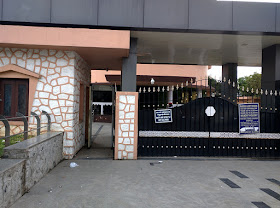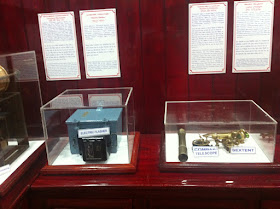Madras Lighthouse, Mylapore, Chennai
The Madras
Light House is a lighthouse facing the Bay
of Bengal on the east coast of
the Indian Subcontinent. It is in Mylapore in Chennai City of Tamilnadu. It is
a famous landmark on the Marina
Beach in Chennai, India. It was built by the East Coast Constructions and
Industries in 1976 replacing the old lighthouse in the northern direction. The
lighthouse was opened in January 1977. It also houses the meteorological
department and was restricted to visitors. On 16 November 2013, it was reopened
to visitors. It is one of the few lighthouses in the world with an elevator.
It is
also the only lighthouse in India within the city limits. It is also a
green lighthouse, with a solar panel for power. The Chennai Lighthouse is an
unmistakable city landmark on Marina Beach. You can clearly spot it punctuating
the skyline close to the seashore. The lighthouse soars to a height of 46
meters (161 feet) and the light source is at a height of 57 meters. During the
2004 tsunami, when Marina Beach was devastated, the base of the lighthouse
tower was damaged.
History
For
brief details, please refer below link;
The
Chennai Lighthouse District
The
Chennai Lighthouse, along with 23 other lighthouses along the eastern, southern
and western coast of the Indian peninsula, comes under the administration of
the Chennai Lighthouse District. In accord with the Lighthouse Act of 1927 and
the Lighthouse (Amendment) Act of 1985, the Chennai Lighthouse District
comprises under its jurisdiction part of Kerala State which is
south of latitude 9º00'N and state of Tamil
Nadu, which is south of latitude 13º00'N and west of longitude 80º30'E and the union territory of Puducherry, which include the following lighthouses:
1. Alleppey
2. Kovil Thottam
3. Tangasseri Point (Quilon)
4. Anjengo
5. Vilinjam
6. Muttam Point
7. Kanyakumari (Cape Comorin)
8. Manappad Point
9. Pandiyan Tivu DGPS
10. Kilakkarai
11. Point Calimere
12. Kodikkarai
13. Ammpattinam DGPS
14. Pasipattinam
15. Rameswaram
16. Pamban
17. Nagapattinam DGPS
18. Karaikal
19. Porto Novo
20. Cuddalore Channel Buoyage
21. Pondicherry Lighthouse and DGPS
22. Mahabalipuram
23. Madras (Chennai)
24. Pulicat DGPS
2. Kovil Thottam
3. Tangasseri Point (Quilon)
4. Anjengo
5. Vilinjam
6. Muttam Point
7. Kanyakumari (Cape Comorin)
8. Manappad Point
9. Pandiyan Tivu DGPS
10. Kilakkarai
11. Point Calimere
12. Kodikkarai
13. Ammpattinam DGPS
14. Pasipattinam
15. Rameswaram
16. Pamban
17. Nagapattinam DGPS
18. Karaikal
19. Porto Novo
20. Cuddalore Channel Buoyage
21. Pondicherry Lighthouse and DGPS
22. Mahabalipuram
23. Madras (Chennai)
24. Pulicat DGPS
The
director general at the Directorate General of Lighthouses and Lightships
located at Noida has under him or her four deputy director
generals, namely, Jamnagar, Chennai, Kolkata and the headquarters. For administrative control,
the entire coastline has been divided into seven districts having their
regional headquarters at Jamnagar, Mumbai, Cochin, Chennai, Visakhapatnam, Kolkata and Port
Blair. The Chennai Lighthouse District
is administrated under the Regional Director (Chennai), who along with the
Regional Director (Cochin) comes under the deputy director general (Chennai). The
Regional Office at Chennai provides information on the geographical region
between Alleppey Lighthouse to Pulicat Lighthouse. The union government is
planning to build three new lighthouses in the Chennai Lighthouse District at
an estimated cost of Rs 25 million each.
The
Towers
The Entrance Channel Tower:
Located
north of the port, the entrance channel tower is about 24 metres (79 ft)
high with a focal plane of 26 metres (85 ft), flashing white, red and
green lights, and the tower is visible only from a distance closer to the
entrance channel. This tower was assigned an Admiralty number of F0938 and NGA
number of 27074. This tower is still active.
The First Tower (1796–1844):
The
first light at Madras is a lantern on the wall of the Fort
St. George. With the growth of commercial
activities of the English East India Company, the company built a lighthouse at
the Fort in 1796. Functioning from the roof of the Officer's Mess, now housing
the Fort Museum, it comprised a lantern with large oil-fed wicks. The
light has been inactive since 1844.
The Second Tower (1844–1894):
The
second lighthouse was a tall granite Doric column erected in 1841 and is located within the
compound of the Madras
High Court to the north of Fort
St. George. Work began in 1838 and completed
in 1843 at a cost of Rs 75,000, and the lighthouse started
functioning on 1 January 1844. This round fluted stone tower with gallery
is 38 metres (125 ft) tall. Built on a base of 55-feet breadth, its
column rises 84 feet with a tapering diameter—16 feet at the base and 11 feet
at the top.
The
entire structure from base to tip has a height of 125 feet. The light was
at 117 feet and was visible 20 miles into the sea. Illumination was by 15
"argand lamps with parabolic reflectors, arranged in three tiers."
Unlike the earlier rotary model, it had a reciprocal type of light, with the
ratio of bright-to-dark periods being 2:3 and with each unit of time being 24 seconds.
This
tower was assigned an ARLHS number of IND-027. Given the inability of brick to
withstand saline breeze of the sea, the surface of the tower was built with
granite procured from quarries at Pallavaram. However, following the
construction of the taller High Court building in 1892, mariners started having
difficulty in identifying the tower during daytime. The tower became inactive
since 1894 after the lighthouse was moved atop the dome of the main tower of
the new High Court building.
The Third Tower (1894–1977):
The
lantern from the second tower was moved to one of the tallest ornate towers of
the Madras High Court building, which was constructed adjacent to the second
tower in 1892. The lighthouse started functioning from 1 June 1894. According
to I. C. R. Prasad's book Madras Lighthouse, the lantern room was erected
on the gilded dome, with a cutting in the dome and the spiral staircase serving
as entry to the top. The lighthouse used kerosene vapour lamps. The
revolving light was supplied by Chance Brothers from Birmingham. The capillary lamp of this light was capable of
producing 18,000 candelas power. It was assigned an ARLHS number of IND-026.
This tower became inactive since 1977, after guiding British and Allied
warships of both the world
wars.
The Fourth Tower (1977 – present):
The
present lighthouse is a triangular cylindrical, red-and-white-banded, concrete
one with lantern and double gallery and is 11 stories high. The tower is
attached to a three-story circular harbour-control building. The total height
of the tower is 45.72 metres (150.0 ft) with the light source standing at
a height of 57 metres (187 ft) from the mean
sea level. The source consists of 440V
50 Hz main supply (with standby Genset), with a range of 28 nautical
miles. It is functional since 10 January 1977. The base of the present
lighthouse tower was damaged by the waves from the Indian Ocean tsunami of 26 December 2004, but there were no reported
casualties. Chennai Lighthouse has the distinction of being one of the few
lighthouses with an elevator facility in the world. The lighthouse is 11
stories high and is the only one in India with an elevator.
Security
The
ninth floor of the tower has a viewing gallery where steel welded mesh panels
have been erected for safety. This has been done to avoid suicide attempts, which
were witnessed in the past. The tenth floor has a high-security radar installed
and is not open to public. The elevator in the lighthouse will take the
visitors directly to the viewing gallery on the ninth floor, and visitors will
not be given access to any other floors. The lighthouse was open to the public
until the assassination of former Prime Minister Rajiv
Gandhi, following which it was shut down
over fears that it would be the target of an attack. It was re-opened for
visitors on 14 November 2013.
Developments
Chennai
Lighthouse is one of the 13 lighthouses in India that are identified as
heritage centers to portray maritime history of India. A lighthouse museum
has been planned at a cost of Rs 50
million. The union shipping ministry is planning to build museums, rooms,
cafeteria, souvenir shop, viewers gallery, 4D cinema hall, gaming zone and
aquarium at the Chennai lighthouse. The heritage museum will showcase the history
of marine navigation, where oil-bearing large wicks, kerosene lights, petroleum
vapour, and electrical lamps used in the past will be on display.
Directorate
General of Lighthouses and Lightships has planned the remote control and
automation of lighthouses in Cochin, Chennai, Vishakhapatnam and Kolkata
directorates at a cost of Rs 304.5 million. As a
first step towards automation of lighthouses, Radone, an equipment that can
detect radar signals from ships and helps captains identify the location, has
been installed on most lighthouses. The automation of lighthouses in the
Chennai Lighthouse District is estimated to cost about Rs 50 million during the 11th Five-Year Plan. The 22
lighthouses in the Chennai Lighthouse district will be monitored and controlled
from conveniently located positions termed as Remote Control Stations (RCSs).
These RCSs will be ultimately linked to Master Control Station, proposed to be
located at Chennai for effective control.
Entry
Timings
·
Mon-Sun: 10:00 AM - 10:00 PM
Fees Structure
·
Rs.10 per head for
adult
·
Rs.5 per head for
children,
·
Rs.25 for Camera,
·
Rs.5 for museum.
Contact
Madras
Lighthouse,
Mylapore,
Chennai –
600 004
Phone: +91 44 24985598
Connectivity
For
brief details, please refer below link;

































